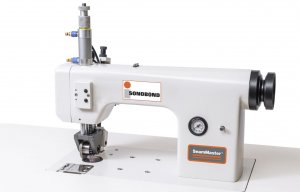
Sonobond becomes part of Inductotherm
Graphene has been described as the new wonder material, being around 100 times stronger than steel and a powerful conductor of both heat and electricity.

8th November 2016
Innovation in Textiles
|
Geneva
Graphene has been described as the new wonder material, being around 100 times stronger than steel and a powerful conductor of both heat and electricity. It is also the most hydrophobic material known and also totally impermeable to gas. Its invention by Andre Geim and Konstantin Novoselov of the University of Manchester in 2003 earned the two scientists the Nobel Prize for Physics in 2010.
Graphene is widely seen as a new platform material for advanced manufacturing, with applications in electronics, wearable technology, mining, water conservation and purification, automotive structures and energy storage.
Now, two Australian companies are exploiting the material as a tool for adding intelligence to nonwoven geotextiles.
In June this year, Imagine IM opened Australia’s first commercial graphene plant in Geelong, Victoria, with an annual capacity of up to ten tons of the material.
The company has now teamed up with Geofabrics Australasia, which has been manufacturing the famous Bidim-branded needlepunched polyester nonwoven fabrics since 1978 and today operates two plants in Albury, New South Wales and Southern Queensland.
Together the two companies have completed the first independent field trials of Imagine IM’s imgne® X3 graphene coating on geotextiles and report extremely positive results. The conductive geotextiles make leak detection easier and more reliable, in addition to providing an easier way of electrically joining them in place to make the materials more robust. Applications are envisaged in lining systems for landfills, mining, wastewater treatment plants, reservoirs, industrial processing facilities, dams and other containment projects.
The field trials carried out by the two companies were conducted using a standard commercial 2mm thick HDPE geomembrane in a two-layer configuration, ensuring its maximum electrical insulation. This is the most difficult condition for electrical leak detection. Testing was to ASTM standards using two-metre-wide wide, 25-metre long samples of the geotextile, coated on one side only. Deliberate, controlled holes were drilled into the geomembrane in diameters down to 1mm and could be detected using normal testing methodologies and equipment for trials of this kind.
Notably, no special installation of the geotextiles was required and no welding or other specialised joining was required. Instead, electrical joins between adjacent treated geotextiles were achieved with a simple 100mm overlap. It was also proven that continuing conductivity could be achieved with overlaps down to only 10mm.
Testing sensitivity was proven to be constant at earth-lead distances from a metre to 20m metres and holes were successfully detected at 15kV test voltage in – even when there were deformations in the geomembrane. Using standard brush pressure to ensure good geomembrane to conductive geotextile contact during testing, reliable results were registered even at 5kV test voltage. There were no false positives in any of the test results.

In all tests, standard installation techniques were used with no special handling or preparation of coating, geomembrane or the ground itself.
“We developed imgne X3 as a graphene-based coating that enables the delivery of conductivity in textiles and on other materials without impacting the strength and other characteristics of the materials themselves,” said Imagine IM COO Phillip Aitchison. “The development is a major milestone for us. We have now proven our ability to both manufacture graphene at scale, and also to be able to produce masterbatch solutions that will enable large-scale industrial applications using graphene to make smart materials.”
“The intent of using imgne X3 is to provide a methodology for making geotextiles conductive that will lead to substantial saving for end-users and to make leak detection more affordable and more accurate,” added CEO Chris Gilbey. “Imagine IM’s focus is on developing applications that utilise the amazing properties of graphene to enable the manufacture of transformative smart textiles, fibres and membranes. Our initial pilot plant will serve the needs of Geofabrics over the next two years and will provide sufficient graphene for other products that are currently in R&D. We are now confident that our product can be manufactured at scale and will perform according to the needs of end-users and, equally importantly, that it will be able to deliver substantial economies by requiring less complex installation procedures.”
The global geosynthetics industry is expected to reach a value of US$16 billion per year by 2018, and is currently growing at 10% annually, driven by increasing environmental regulations including the management of water related issues in civil engineering and mining.
A dedicated geotextiles sector seminar is scheduled at INDEX™17, with leading experts to address the solutions these products can bring to the geotextiles and construction sectors.
At INDEX™17, taking place from 4-7 April 2017 at Palexpo in Geneva, four dynamic nonwovens industry applications will be highlighted. Accompanied by high-level keynote speakers, free conferences and tutorials, the Transportation, Medical, Geotextiles and Filtration segments have been singled out for special focus.
In addition, for the first time, the well-renowned FILTREX conference will take place in parallel with INDEX™, on 5 and 6 April.
Register to receive latest news and developments from INDEX™17

Business intelligence for the fibre, textiles and apparel industries: technologies, innovations, markets, investments, trade policy, sourcing, strategy...
Find out more